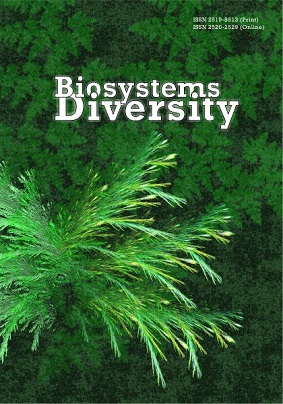Особенности продуктивности сосновых древостоев в лесонасаждениях Северной Степи Украины
Analysis of the productivity of pine stands in plantations in the Northern Steppe of Ukraine
Author(s): Y. Gritsan, K. P. Maslikova, S. A. Sytnyk, V. M. LovynskaSubject(s): Sociobiology
Published by: Дніпропетровський національний університет імені Олеся Гончара
Keywords: Pinus sylvestris L.; Northern Steppe of Ukraine; stand density; pure and mixed stands;
Summary/Abstract: The aim of this work is the comparative analysis of the productivity of Scots pines in pure and mixed plantations with main and accompanying species in the Northern Steppe of Ukraine We analysed the taxation parameters such as height, diameter, stand density, which vary with the age of the stand and composition of the plantation. Within the study area pines grow mainly in pure stands (81.9%). The share of mixed forest stands in the study area is only 18.1%. The analysis of representation of age structure showed the presence of the same proportion of the young age group in pure and mixed stands, the dominant share being taken up by middle-aged monoculture stands, and thus a smaller area taken up by mature and over mature pines. The average stand density per 1 ha in pure stands of all age groups is 17% higher than in mixed stands. The dynamics of variations of such biometric data as average height, diameter and density for the different compositions of Scots pine stands were measured for 14 age classes. The mean heights of the pure and mixed stands were close, while the average diameter gradually increased with age, reaching its maximum in over mature plantations. The research results showed that there is an excess of this parameter in the mixed compared with the pure stands. We did not find significant differences between middle age pure and mixed stands in accumulation of stand density. But pure pine stands show a clear tendency to dominate in wood accumulation in all age classes through the period of growth. The greatest difference between pure and mixed stands in the mean stand density was observed for those of middle-age. The average stand density in the pure stands was up to 32% higher than the mixed. The area distribution of Scots pine stands according to productivity was as follows. The largest area for both pure and mixed stands was occupied by trees of quality class I, which took up 54.3% of the total pure pine acreage and 41.9% of the mixed stand acreage. The second position was occupied by quality class II, which occupied 27.6% of total pure pine acreage and 36.6% of mixed stand acreage with the percentage of total stand density at 23.6% and 35.1% respectively. In general, the value of the average stand density falls as the quality class decreases, and essentially depends on the composition of plantations: in pure stands, it is higher than in mixed. The investigated values of the biometric parameters are statistically significant for both the pure and the mixed stands.
Journal: Biosystems Diversity
- Issue Year: 25/2017
- Issue No: 1
- Page Range: 39-44
- Page Count: 6
- Language: Russian

